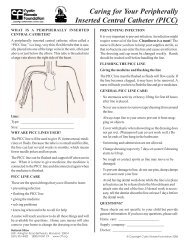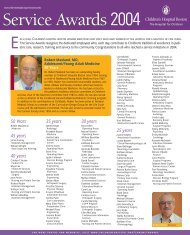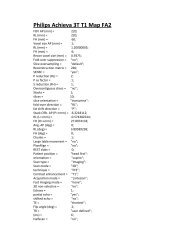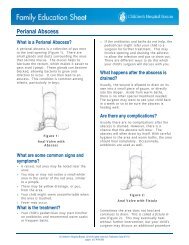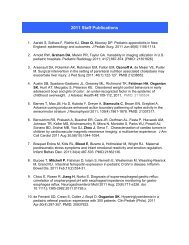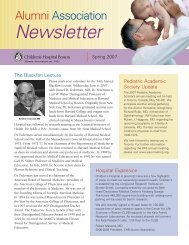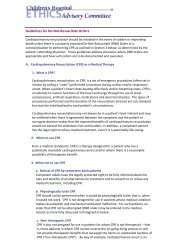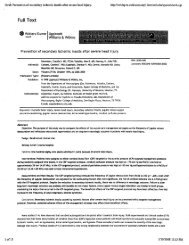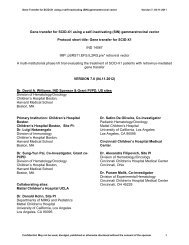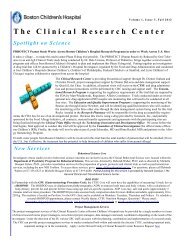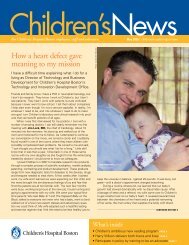magic bullet - Children's Hospital Boston
magic bullet - Children's Hospital Boston
magic bullet - Children's Hospital Boston
Create successful ePaper yourself
Turn your PDF publications into a flip-book with our unique Google optimized e-Paper software.
Children’s <strong>Hospital</strong> <strong>Boston</strong> December 2003<br />
Pediatric Views<br />
Autism diagnosis, treatment elude ‘<strong>magic</strong> <strong>bullet</strong>’<br />
On first impression, 5-year-old Peter<br />
does not seem to have special needs.<br />
His watchful eyes light up when he<br />
sees a toy rocket he likes, and he is perfectly<br />
agreeable as Ellen Hanson, PhD, invites him<br />
to play some games with her. Dr. Hanson, a<br />
psychology fellow in the Developmental<br />
Medicine Center at Children’s <strong>Hospital</strong> <strong>Boston</strong>,<br />
is evaluating the progress of Peter’s intensive<br />
therapy for autism—in part because officials at<br />
Peter’s school insist, despite a clear diagnosis,<br />
that he suffers from ADHD or another disorder.<br />
For schools and parents, it can be difficult<br />
to see the connection between behavior such<br />
as Peter’s and autistic spectrum disorder. Peter<br />
functions on the high end of the autistic spectrum—well<br />
above the 80 percent of autistic<br />
children with co-morbid mental retardation,<br />
language disability or severe disconnection<br />
from the external world. Yet as Dr. Hanson<br />
and Janice Ware, PhD, associate director of<br />
the Developmental Medicine Center, conduct<br />
Peter’s evaluation, they illuminate the subtle<br />
and not-so-subtle signs of high-functioning<br />
autism.<br />
For example, although Peter is well<br />
behaved, he makes few social references such<br />
as seeking parental approval or making eye<br />
contact. He plays happily with Dr. Hanson,<br />
but fixates on the toy rocket and ignores<br />
every attempt by his playmate to develop an<br />
interaction. He learns a short story about a<br />
bird, but retells it without elaboration, gesture<br />
or inflection.<br />
Diagnosing autism can be particularly difficult<br />
for primary care providers, who only see<br />
a snapshot of child behavior and interactions<br />
in a typical office visit. And unfortunately,<br />
there is no simple checklist of screening questions<br />
that can make the task any easier. “I’ve<br />
asked many pediatri-<br />
continued on page 7<br />
Digital picture system improves service and care<br />
S. Ted Treves, MD, vice-chair of Radiology IT and<br />
chief of Nuclear Medicine, views a high-resolution<br />
image over Children’s PACS network.<br />
IN THIS ISSUE<br />
2 Q&A: Racial disparities<br />
3 RSV<br />
Children’s <strong>Hospital</strong> <strong>Boston</strong>’s<br />
Department of Radiology is in the<br />
final stages of implementing a new<br />
digital archive of radiological images, known<br />
as Picture Archiving and Communication<br />
System (PACS), that has made film a thing<br />
of the past, and in the process improved<br />
both customer service and patient care.<br />
According to S. Ted Treves, MD, vicechair<br />
of Radiology IT and chief of Nuclear<br />
Medicine, the goal is to allow Children’s<br />
staff to share “any image, any time, any<br />
place” within the hospital network. The<br />
system functions as a state-of-the-art<br />
repository for long-term archiving of digital<br />
images, and includes the backup and<br />
bandwidth to safeguard uninterrupted<br />
network availability.<br />
3 Osgood-Schlatter’s syndrome<br />
5 CME corner<br />
• The average age of autism diagnosis in<br />
the U.S. is 8 years; in <strong>Boston</strong>, the average<br />
falls between 3 and 5 years.<br />
Children’s <strong>Hospital</strong> <strong>Boston</strong> makes most of<br />
its diagnoses before age 3.<br />
• The earlier autistic spectrum disorder is<br />
caught, the earlier intervention can<br />
begin. However, at very young ages there<br />
is no reliable way to determine how<br />
severe the problem is.<br />
• Early evaluations can give false<br />
negatives, as mild disorders on the spectrum,<br />
such as Asberger’s Syndrome, are<br />
easily missed at a young age.<br />
• Autism is often misdiagnosed as a language<br />
disability, mental health issue,<br />
obsessive-compulsive disorder or ADHD.<br />
The project has already:<br />
• Augmented the ability of clinicians<br />
to get information—and act upon<br />
it—much more quickly. Whether the<br />
brace shop at Children’s main campus,<br />
which makes prosthetics and<br />
orthotics, needs precise<br />
measurements from an X-ray, or a<br />
neurologist at the South Shore<br />
<strong>Hospital</strong> needs printouts of an MRI<br />
scan, the image is only a mouse-click<br />
away.<br />
• Improved patient care by allowing<br />
specialists at different locations to<br />
access an image simultaneously.<br />
continued on page 6<br />
7 Children’s to add PET scanner<br />
8 Children’s Health Network
Q&A: Racial disparities in health care<br />
Tracy Lieu, MD, MPH, is a Children’s pediatrician and the director of the Center for Child Health Care Studies, a<br />
research and teaching collaboration between Harvard Medical School and Harvard Pilgrim Health Care. She recently talked<br />
to Pediatric Views about the implications her research may have for understanding racial disparities in health care.<br />
How serious are racial disparities in<br />
health care?<br />
It’s quite a serious problem, and<br />
extremely pervasive. The healthcare<br />
system has effective ways of improving<br />
health, but these are sometimes not<br />
reaching the populations that need<br />
them most. It would be a simple issue<br />
if we could blame all of the disparities<br />
on financial access to care, but it turns<br />
out to be far more complex than that.<br />
In studies that have looked at patients<br />
who have good insurance and good<br />
financial access to health care, it turns<br />
out that black adults and children are<br />
sometimes still less likely to receive<br />
effective services than white children<br />
and adults. There are many researchers<br />
trying to figure out why that is.<br />
What can your research on asthma<br />
tell us about health care disparities<br />
in general?<br />
Asthma is one of the most important<br />
diseases in childhood, and it affects<br />
black children more often and more<br />
severely than it affects white children.<br />
No one, however, has been able to say<br />
exactly why. In addition, if a black<br />
child and a white child have asthma<br />
attacks of equal severity, the black<br />
child is more likely to be hospitalized.<br />
This raises some complex questions:<br />
Are doctors less likely to recommend<br />
preventive medicines to black patients?<br />
Are black families less likely to adopt<br />
these medicines if they are recommended?<br />
We don’t completely understand<br />
what’s going on, but we think<br />
that the lapse in care probably lies in<br />
patterns of communication between<br />
physicians and parents. For example, a<br />
doctor might recommend appropriate<br />
How to reach us<br />
Main number<br />
(617) 355-6000<br />
Call Center<br />
(800) 355-7944<br />
Emergency Services<br />
(617) 355-6611<br />
preventive medicine for a child with<br />
asthma, but if a communication gap<br />
occurs, the parent may not understand<br />
that it’s meant to be used every day.<br />
The hypothesis is that these types of<br />
gaps arise more frequently for black<br />
and Latino families.<br />
Your research focuses on “culturally<br />
tailored interventions.” What do you<br />
mean by that?<br />
Culturally tailored interventions try to<br />
take into account the fact that families<br />
from different cultures come to the<br />
healthcare setting with different beliefs<br />
about what causes disease, what medicines<br />
are for and the risks that medicines<br />
may have.<br />
How can this understanding be<br />
integrated into patient care?<br />
There are many types of policies that<br />
health care systems may put into place<br />
to try to address these issues. They<br />
may hire more bilingual providers or<br />
interpreters, or give everyone training<br />
in cultural sensitivity. There are also<br />
fairly simple logistical steps, like printing<br />
patient information in different languages<br />
and representing all races in<br />
your printed materials.<br />
In one recent study, we found that<br />
practice sites with stronger policies<br />
promoting cultural competence not<br />
only received more positive feedback<br />
from families, but also showed better<br />
rates of preventive medicine use among<br />
minority patients. That was surprising<br />
to me—I wouldn’t have guessed that<br />
improvement in care would be so<br />
closely associated with action at the<br />
policy level.<br />
Transport Team<br />
(866) 355-7944<br />
TTY<br />
(800) 355-8021<br />
How Children’s <strong>Hospital</strong> <strong>Boston</strong> is<br />
addressing cultural competence:<br />
In 1999, Children’s staff published<br />
“Honoring Patient Preferences: A<br />
Guide to Complying with Multicultural<br />
Patient Requirements” (Jossey-Bass).<br />
This is one of many resources made<br />
available to Children’s staff on understanding<br />
diverse religious and<br />
cultural traditions.<br />
In 2001, Children’s established a<br />
Diversity and Cultural Competency<br />
Task Force to focus on cultural competence<br />
issues in family education<br />
and services, human resources and<br />
staff training, and clinical and support<br />
services.<br />
Beginning in 2004, Children’s new<br />
director of Diversity and Cultural<br />
Competence will lead a comprehensive<br />
analysis of the hospital’s existing<br />
diversity initiatives and resources in<br />
this area, and will be charged with<br />
improving, coordinating and expanding<br />
upon those efforts.<br />
For more information on Dr. Lieu’s<br />
work, see “Racial/Ethnic Variation in<br />
Asthma Status and Management<br />
Practices Among Children in Managed<br />
Medicaid,” Pediatrics,<br />
May 2002.<br />
For resources on culturally effective<br />
pediatric care from the American<br />
Academy of Pediatrics visit:<br />
www.aap.org/commpeds/cepc/<br />
resources.htm<br />
On the Web<br />
www.childrenshospital.org
’Tis the Season for RSV Susan Hamilton-Bruno, RN, MS<br />
As a pediatric critical<br />
care clinical<br />
nurse specialist in<br />
the Medical/<br />
Surgical Intensive<br />
Care Unit at<br />
Children’s<br />
<strong>Hospital</strong> <strong>Boston</strong>, I<br />
never look forward to the return of the<br />
winter viral season, primarily because<br />
of one culprit: respiratory syncytial<br />
virus (RSV). It is hard to predict how<br />
intense this virus will hit in any given<br />
year, so Children’s ICU always prepares<br />
for an influx of RSV patients by reviewing<br />
infection control procedures and<br />
updating staff on current RSV management<br />
strategies.<br />
It is estimated that as many as<br />
126,000 U.S. children under 1 year old<br />
are hospitalized with RSV every year.<br />
Infants considered at highest risk are<br />
Knee pain is common in adolescents who experience a rapid<br />
growth spurt, but in physically active teens, such pain is just<br />
as likely to indicate an acute or overuse injury. In the case of<br />
Osgood-Schlatter’s syndrome (OS), both growth and injury<br />
can play a role, and activity restrictions provide the best<br />
route to an excellent prognosis.<br />
OS is a traction apophysitis of the tibial tuberosity, or<br />
inflammation created where a tight patella tendon creates<br />
tension, pulling away from bone attachment below the knee.<br />
The problem is associated with growth spurts, since rapidly<br />
lengthening bones cause the quadriceps, hamstring, gastrocnemius<br />
muscles and their tendons to become tight and<br />
inflexible, creating tension and tenderness at the insertion of<br />
these muscle tendons to the bone. A bony prominence can<br />
often develop over the traction site, causing discomfort with<br />
kneeling and contact. This condition becomes exacerbated<br />
by sports requiring repetitive quadriceps contractions.<br />
Although it is generally a benign condition, OS is one of<br />
the most common causes of knee pain in adolescent athletes.<br />
More serious consequences, including formation of a free<br />
ossicle at the site of traction that may require surgical excision,<br />
can be avoided with early diagnosis and treatment.<br />
those with underlying chronic conditions<br />
such as prematurity, congenital<br />
heart disease or lung disease. Any<br />
infants who fit into these high-risk categories<br />
or have extreme tachypnea,<br />
wheezing or respiratory distress, consolidation<br />
on chest x-ray, or overall<br />
toxic appearance should be referred for<br />
possible admission.<br />
Care for RSV continues to be mostly<br />
supportive. Approximately two percent<br />
of all patients hospitalized require<br />
mechanical ventilation. Indications for<br />
intubation include apnea, severe desaturation<br />
episodes or respiratory failure evidenced<br />
by elevated carbon dioxide and<br />
decreased oxygenation on arterial blood<br />
gas. Care is directed at maintaining oxygenation,<br />
assuring adequate hydration<br />
and providing symptom relief. Since<br />
severity of infection and response to<br />
treatments varies greatly, each infant<br />
treated for RSV at Children’s has an<br />
individualized plan of care.<br />
It is important for all healthcare<br />
providers to make the general public<br />
aware of the risks of RSV in infants.<br />
New parents of infants born in the<br />
high-risk months should receive information<br />
about the importance of good<br />
hand washing and other strategies to<br />
protect their infants. Although clinical<br />
professionals are well aware of the<br />
necessity of infection control practices,<br />
the vulnerability of our patients during<br />
this season is a good reason for us to<br />
refresh our own precautions against the<br />
spread of the infection.<br />
For more information on updating<br />
staff on current RSV Management<br />
Strategies, e-mail susan.hamiltonbruno@tch.harvard.edu<br />
Osgood-Schlatter’s Syndrome: A REAL PAIN IN THE KNEE<br />
Brian FitzGerald, BSN, LATC, athletic trainer in Children’s Department of Sports Medicine<br />
Generally, OS can be<br />
treated symptomatically in<br />
the primary care setting.<br />
However, if pain persists<br />
(especially during inactivity),<br />
the patient should be referred<br />
to an experienced specialist<br />
to rule out the possibility of<br />
free ossicle, avulsion fracture,<br />
infection or tumor.<br />
Treatment generally<br />
includes rest and ice until<br />
symptoms subside, followed by stretching and strengthening<br />
exercises of the quadriceps. If on examination the tendon is<br />
“hot” to the touch, the patient should be advised to stop any<br />
activities that aggravate the condition, treat with NSAIDS<br />
and ice. Once the knee is no longer tender, a patient who is<br />
compliant with stretching exercises may return to activity,<br />
but should use an infrapatella strap or patella tracking brace.<br />
Growth plate<br />
Epiphysis<br />
(Articular cartilage)<br />
Apophysis<br />
(Tendon insertion)<br />
To find out more about Children’s Sports Medicine Program, visit<br />
www.childrenshospital.org/sportsmed. To refer a patient,<br />
please call (617) 355-3501 for our <strong>Boston</strong> office, (781) 672-2100 for<br />
Lexington, or (978) 538-3600 for Peabody.<br />
December 2003 ❘ 3
4 ❘<br />
Children’s <strong>Hospital</strong> <strong>Boston</strong><br />
NEW<br />
Old friends catch up at Advances<br />
Lisa Yessayan, MD, of Belmont and Leonard Rappaport, MD,<br />
Director of the Developmental Medicine Center at <strong>Children's</strong><br />
<strong>Hospital</strong> <strong>Boston</strong>, at Advances in Pediatric Healthcare at the Quincy<br />
Marriott on October 8. The next full day educational conference<br />
geared toward Pediatricians will be Frontiers in Pediatric Surgery<br />
on March 24, 2004 at the Renaissance Bedford Hotel in Bedford.<br />
There is a $50 non-refundable<br />
registration fee for this seminar.<br />
After registering and submitting payment, you will<br />
receive a confirmation letter, including directions<br />
to the Renaissance Bedford Hotel in Bedford, Mass.<br />
Frontiers in Pediatric Surgery<br />
Acontinuing medical education series sponsored<br />
by Children’s <strong>Hospital</strong> <strong>Boston</strong> and Harvard<br />
Medical School Department of Continuing<br />
Education, Frontiers in Pediatric Surgery is a new, fullday<br />
conference to inform primary pediatric providers of<br />
the changing trends in pediatric surgery.<br />
To register, please fill out the application below.<br />
For more information, contact Anne Vaccaro, course<br />
coordinator at (617) 355-5186<br />
REGISTRATION FORM<br />
FPS-SP04<br />
Name ________________________________________________________________________________________________<br />
last first<br />
Practice ______________________________________________________________________________________________<br />
Address ____________________________________________________________________________________________<br />
City ______________________________ State ___________ Zip ___________<br />
Daytime Telephone ( ) ____________________________________________<br />
❏ MD ❏ NP ❏ RN ❏ DO ❏ PA ❏ Other<br />
Harvard Medical School is accredited by the Accreditation<br />
Council for Continuing Medical Education (ACCME) to provide<br />
continuing medical education for physicians.<br />
Harvard Medical School designated this educational activity<br />
for a maximum of 6.0 category 1 credits towards the AMA<br />
Physician’s Recognition Award. Each physician should claim<br />
only those credits that he/she actually spent in the<br />
educational activity.<br />
Nursing Staff Development at Children’s <strong>Hospital</strong> <strong>Boston</strong> is an<br />
approved provider of continuing education by the Ohio<br />
Nurses Association, an accredited approver by the American<br />
Nurses Credentialing Center’s Commission on Accreditation.<br />
6.0 Contact Hours are currently pending for this conference.<br />
Please mail this application, along with a check or money<br />
order made payable to Children’s <strong>Hospital</strong> <strong>Boston</strong>, to:<br />
Anne Vaccaro, Course Coordinator<br />
Children’s <strong>Hospital</strong> <strong>Boston</strong><br />
Department of Medicine<br />
300 Longwood Avenue - Hunnewell 3<br />
<strong>Boston</strong>, MA 02115<br />
(617) 355-5186
Wednesday, March 24, 2004<br />
Course Schedule<br />
7:30–8:20 am Sign-in and Reception<br />
8:20–8:30 am Introduction and Welcome<br />
Robert Shamberger, M.D.<br />
8:30–9:00 am GER: Surgical Indications and Repair<br />
Tom Jaksic, M.D., Ph.D.<br />
9:00–9:30 am Common Injuries – Evaluation and Treatment<br />
Lawrence Karlin, M.D.<br />
9:30–10:00 am Workup and Management of Hearing Loss<br />
Greg Licameli, M.D.<br />
10:00–10:30 am Management of Vesico-Ureteral Reflux<br />
Joseph Borer, M.D.<br />
10:30–11:00 am Break<br />
11:00–11:25 am Craniosynostosis – When Should I Refer the<br />
Child with an Unusual Head Shape<br />
Mark Proctor, M.D.<br />
11:25–11:50 am Plagiocephaly<br />
Gary Rogers, M.D.<br />
11:50–12:15 pm Strabismus: Update on Diagnosis and<br />
Treatment<br />
David Hunter, M.D., Ph.D.<br />
12:15–1:00 pm Lunch<br />
1:00–1:30 pm Pelvic Pain<br />
Marc Laufer, M.D.<br />
1:30–1:55 pm Trouble Around the Groin:<br />
Hernias, Hydroceles and UDTs<br />
Catherine Chen, M.D., M.P.H.<br />
1:55–2:20 pm Workup and Evaluation of the Neck Mass<br />
Dwight Jones, M.D.<br />
2:20–2:45 pm Management of Disorders of the<br />
External Genitalia Including Hypospadias<br />
Marc Cendron, M.D.<br />
2:45–3:15 pm Dislocated Hips and Common<br />
Neonatal Problems<br />
James Kasser, M.D.<br />
3:15–3:30 pm Closure and Evaluations<br />
All speakers are from Children’s <strong>Hospital</strong> <strong>Boston</strong><br />
unless otherwise indicated.<br />
CME corner<br />
Children’s <strong>Hospital</strong> <strong>Boston</strong> and Harvard Medical School’s Department of<br />
Continuing Education present the Pediatric Health Care Summits. The summits<br />
are free, community-based continuing medical education seminars<br />
designed to inform primary pediatric providers of trends in the management<br />
of common pediatric health concerns. For more information or to register,<br />
visit www.childrenshospital.org/resources/cme/courses.cfm or call<br />
Physician Relations at (617) 355-2454.<br />
Beverly <strong>Hospital</strong><br />
Date/Time April 2, 2004 7 am - 12:30 pm<br />
Topics<br />
TBD<br />
Location<br />
85 Herrick Street, Beverly, Mass.<br />
Credits 4 hours<br />
South Shore <strong>Hospital</strong><br />
Date/Time May 20, 2004 7 am - 12:15 pm<br />
Topics<br />
• Promoting Healthy Bones in Children and Adolescents<br />
Catherine Gordon, MD, MSc<br />
• Overuse Injuries in Children and Adolescents Lyle Micheli, MD<br />
• Headaches David Urion, MD<br />
Location<br />
Emerson Conference Room<br />
55 Frogg Road, South Weymouth, Mass.<br />
Credits 3 hours<br />
MetroWest Medical Center<br />
Date/Time June 3, 2004 7:30 am – 12:30 pm<br />
Topics<br />
• Dermatology for the Primary Care Provider Stephen Gellis, MD<br />
• Pediatric Depression Brigid Vaughan, MD<br />
• School/Behavioral Concerns Related to Learning/Attention<br />
Alison Schonwald, MD<br />
• Sports Injuries: Prevention & Treatment<br />
Keith Loud, MD, CM<br />
Location<br />
Perini Auditorium<br />
115 Lincoln Street, Framingham, Mass.<br />
Credits<br />
4 hours<br />
Pediatric Views • December 2003 ❘ 5
6 ❘ Children’s <strong>Hospital</strong> <strong>Boston</strong><br />
Children’s <strong>Hospital</strong> at Lexington:<br />
A “Decade of Caring”<br />
In October, staff and employees of Children’s <strong>Hospital</strong> at Lexington celebrated<br />
“A Decade of Caring” as they marked the facility’s 10th birthday and honored<br />
more than 50 care providers who have worked at the site since it opened.<br />
Launched in 1993 as a joint venture with Beth Israel Deaconess Medical<br />
Center (BIDMC), Lexington was one of Children’s first full-service satellite health<br />
care centers. It offers more than 20 outpatient specialty services and 10 ancillary<br />
services. “We are proud that we have been able to bring world class medicine to<br />
families close to their homes,” says Jane Venti, executive director of the Lexington<br />
satellite. “Based on our growth, it is clear that this community enjoys the access<br />
and convenience of the care we provide.”<br />
Since the site’s opening, the volume of pediatric specialty care at Lexington<br />
has grown from 8,500 visits within 20 specialties to over 32,000 visits within<br />
24 specialties. In addition, 2,300 ambulatory surgeries were performed there<br />
last year alone.<br />
PACS<br />
continued from page 1<br />
• Created a permanent, non-degradable<br />
archive that eliminates the<br />
incidence of lost film.<br />
Direct access to the system is available<br />
throughout the hospital and its<br />
satellites, as well as to external physicians<br />
who have admitting privileges.<br />
The customer service benefits, however,<br />
will affect all patients and referring<br />
providers by reducing wait times for<br />
images and reports.<br />
Children’s is not the first to adopt a<br />
PAC system, since many comparable<br />
institutions have a similar system in<br />
place. But Dr. Treves believes Children’s<br />
VR trims turnaround time<br />
A second high-tech initiative in<br />
Children’s Department of Radiology,<br />
implemented hand-in-hand with PACS,<br />
is a new Voice Recognition system. It<br />
has already proven its effectiveness<br />
by reducing the average turnaround<br />
time for transcribed reports from 72<br />
hours to just four hours.<br />
adopted PACS at a crucial point for the<br />
technology. “We were able to learn from<br />
the experience of institutions who took<br />
this road before us, while leapfrogging<br />
their abilities technologically. The timing<br />
At the Lexington satellite, Children’s<br />
provides pediatric care and BIDMC<br />
focuses on adults. The two institutions<br />
share capital expenditures (such as<br />
real estate) and operating costs for<br />
high-tech services such as ambulatory<br />
surgery, radiology and lab services.<br />
For more information visit www.childrenshospital.org/visiting/locate/lexingtn.html. To schedule an appointment, call<br />
(781) 672-2100<br />
made it simpler for us to implement<br />
PACS, allowed us to build a more modern<br />
infrastructure, and allowed us to<br />
extend the system to any conventional<br />
PC on the network.”<br />
For more information on the<br />
Department of Radiology visit<br />
www.childrenshospital.org/radiology.<br />
Referring physicians with admitting<br />
privileges to Children’s and a secure<br />
ID card can gain access to PACS. For<br />
training information call<br />
(617) 355-6000 and page #7227<br />
CHILDREN’S OUTLOOK – sign up today!<br />
Children’s bi-monthly newsletter will connect you to the clinical expertise of Children’s specialists and subspecialists,<br />
news from our research labs, information on continuing medical education events and other useful<br />
topics. To sign up for this free service, visit subscribe.chnews.org
Anew diagnostic imaging technology<br />
will soon be at<br />
Children’s <strong>Hospital</strong> <strong>Boston</strong>. In<br />
January 2004, the Division of Nuclear<br />
Medicine will begin imaging patients in<br />
its new Positron Emission Tomography<br />
(PET) scanner. It will be one of the few<br />
such machines in the country used<br />
exclusively for pediatrics.<br />
“This will be a tremendous benefit to<br />
our patients, because PET allows us to<br />
see functional distribution and changes<br />
in the body,” says S. Ted Treves, MD,<br />
chief of the Division of Nuclear<br />
Medicine. A three-dimensional imaging<br />
technique that depicts the distribution<br />
of radiopharmaceuticals within the<br />
Autism<br />
Pediatric PET will add to imaging capabilities<br />
continued from page 1<br />
cians to name the top indicators for children on the autistic<br />
spectrum, and they’ve all had different answers,” says Dr. Ware.<br />
“The fact is, there is no <strong>magic</strong> <strong>bullet</strong>. You can’t simply count the<br />
number of words a child has acquired by a given age; you have<br />
to assess the quality of the child’s social interactions.”<br />
Although autism was once primarily thought of as a communication<br />
disorder, the most reliable indicators relate to a child’s<br />
inability to relate socially. On balance, says Dr. Ware, there<br />
should be predominantly positive interactions—including the<br />
ability to share attention with others, spontaneous initiation of<br />
social conversation, being flexible and transitioning easily<br />
between activities. Other behavioral indicators to look for<br />
include problems establishing regular sleep patterns, not eating a<br />
body, PET can<br />
help diagnose<br />
disease very<br />
early. “This will<br />
complement<br />
our existing<br />
diagnostic<br />
imaging instruments,<br />
such as<br />
SPECT [Single<br />
Photon Emission<br />
Tomography], MRI and CT. The addition<br />
of PET enhances our team’s ability<br />
to obtain the highest quality studies in<br />
the safest possible way,” says Dr. Treves.<br />
“PET is an exciting technology<br />
because it provides exquisite details of<br />
regional function in the human body,”<br />
says Dr. Treves. Because PET allows the<br />
assessment of chemical and physiological<br />
changes related to function and metabolism,<br />
and these alterations often take<br />
place well before physical or anatomical<br />
changes occur, PET can be a key tool for<br />
very early diagnosis of disease.<br />
PET has already proven extremely<br />
useful to Children’s Oncology, Neurology<br />
and Cardiology units. With respect to<br />
cancer, the technology can help<br />
determine whether certain tumors are<br />
active or inactive and if they have spread<br />
locally, or to distant locations from the<br />
primary tumor. In addition, images<br />
obtained with PET are often used in conjunction<br />
with other imaging modalities<br />
such as CT and MRI to help localize<br />
changes within the body. Combining a<br />
three-dimensional PET, an MRI and a CT<br />
can help determine the precise anatomic<br />
location of active lesions and help optimize<br />
radiation oncology or surgical planning.<br />
Another important property of PET<br />
is that it allows physicians to assess the<br />
success of therapeutic interventions early,<br />
by means of serial scans.<br />
Brain disorders such epilepsy and<br />
brain tumors can also be evaluated<br />
using PET. Other conditions such as<br />
behavioral, learning, metabolic and<br />
cerebrovascular disorders also benefit<br />
from PET assessment. Utilizing standard<br />
diagnostic imaging procedure called<br />
SPECT along with PET, neurologists<br />
and neurosurgeons can more accurately<br />
target the origin of epileptic seizures<br />
prior to surgery.<br />
The use of PET scans in pediatric<br />
cardiology is relatively new. PET can be<br />
used to detect whether heart muscle has<br />
been damaged in a variety of disorders.<br />
To schedule a PET scan appointment,<br />
or for more information, call the<br />
Division of Nuclear Medicine at<br />
(617) 355-7010 or visit<br />
www.childrenshospital.org/nucmed<br />
reasonable range of foods, and being late hitting language development<br />
milestones or not speaking at all.<br />
Since evaluations are complex, time consuming and highly<br />
individualized for each patient, providers who suspect autism<br />
should refer to a developmental medicine specialist immediately.<br />
A specialist can make a diagnosis and determine what<br />
therapies—such as intensive applied behavioral analysis<br />
(ABA), relational intervention and speech pathology therapy—<br />
are appropriate for your patient.<br />
For more information on autistic spectrum disorders, contact<br />
Children’s Developmental Medicine Center at (617)<br />
355-7971 or visit at www.childrenshospital.org/dmc.<br />
Pediatric Views • December 2003 ❘ 7
FRAMINGHAM<br />
WINCHESTER<br />
LEXINGTON<br />
Children’s specialists are closer<br />
than you think<br />
NORWOOD<br />
Published by Children’s <strong>Hospital</strong> <strong>Boston</strong><br />
Departments of Public Affairs and Marketing<br />
© Children’s <strong>Hospital</strong> <strong>Boston</strong>, 2003. All rights reserved.<br />
300 Longwood Avenue<br />
<strong>Boston</strong>, MA 02115<br />
(617) 355-6000<br />
www.childrenshospital.org<br />
BOSTON<br />
BEVERLY<br />
PEABODY<br />
BROCKTON<br />
WEYMOUTH<br />
For more information about the Children’s Health Network site closest to you contact Children’s Call Center at<br />
(800) 355-7944, or visit our Web site at www.childrenshospital.org/locations.<br />
Pediatric Views<br />
Children’s physicians provide multi-disciplinary<br />
pediatric specialty care at locations throughout<br />
Eastern Massachusetts. Children’s specialists in<br />
cardiology, gastroenterology, neurology and<br />
other pediatric subspecialties are easily accessible<br />
to you and your patient families. Locations<br />
are right off Rte. 3, Rte. 24, Rte. 128, I-93, I-95 and<br />
the Mass Pike.<br />
NONPROFIT ORG.<br />
U.S. Postage<br />
PAID<br />
<strong>Boston</strong>, Mass.<br />
Permit No. 59240





